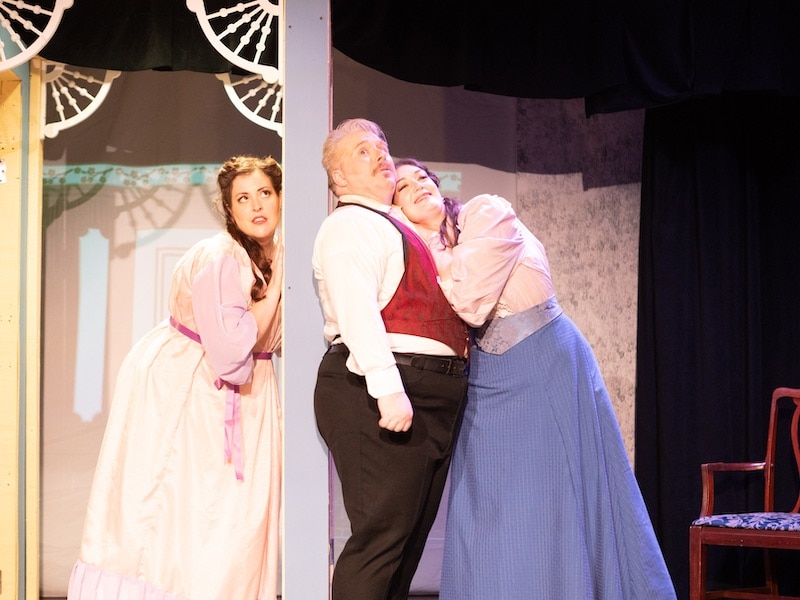The musical A Gentleman’s Guide to Love and Murder has an impeccable and noble pedigree. It is descended from the 1907 novel Israel Rank: The Autobiography of a Criminal by Roy Horniman, by way of the classic 1949 British comedy Kind Hearts and Coronets, which starred Alec Guinness in eight different roles. And the show is a close cousin of Gilbert and Sullivan operettas, with their comedy, catchy yet challenging music, and amusing and intricate patter songs. It premiered on Broadway in 2013 and won four Tony Awards: Best Musical, Book (by Robert L. Freedman), Direction, and Costumes. The delightful score is by Steven Lutvak (who sadly just passed away on October 9 at the age of 64).
The story is much the same as that of the film: Montague Navarro, penniless and newly orphaned, discovers he is eighth in line of succession to be Lord D’Ysquith, Earl of Highhurst. He had not known of this before because the proud, snobbish, and disdainful D’Ysquith family had disinherited his mother when she defied them and eloped with a musician. Monty proceeds to bump off the relations standing between him and the Earldom, all of them played by the same actor. Dark hilarity ensues.

Given Gentleman’s Guide’s operetta roots, there is no local theater group better suited to mount the show than the Victorian Lyric Opera Company. The voices, under the musical direction of Paige Rammelkamp, are uniformly excellent, and ring out powerfully in the small space of the Gaithersburg Arts Barn, accustomed as VLOC is to performing in its much larger home, the F. Scott Fitzgerald Theater. Rammelkamp also accompanies the cast, playing the score on a solo piano, as opposed to relying on backing tracks, as many current amateur productions of the show do. Little is lost, and the live accompaniment allows for nuanced pauses and tempi changes that are unavailable to singers using the recorded score.
VLOC, steeped in Gilbert and Sullivan, is equally adept at comedy, with which this script abounds. In addition to the obvious comic moments in the script, Director/Choreographer Brianna Galligan finds plenty of ways to inject extra humor into the action, such as shrewdly coordinated looks and movements from the cast, or high jinx from individual actors, be it an aristocratic food fight, a policeman chomping on a turkey leg, or a barmaid rolling her eyes. There are several gags involving some sculpted busts on pedestals that are a treat best not spoiled here.
Bill Pressley’s set design, using rear projection plus movable pieces, is up to the job of conveying the show’s multiple locations, from the imposing Highhurst Castle (complete with ghosts of ancestors) to the connecting doors of Monty’s apartment, to a skating pond, and more. There are even painted, vine-covered walls on the sides of the proscenium where each flower contains a different murder weapon. Jordan Hersh’s lighting design handles well the fast switches between the action and Monty’s interior monologues, and the footlights (unusual for the Arts Barn) celebrate the old-fashioned music-hall feel of the show.
Sarah Robinson’s 1909 costumes are well done, showing Monty’s rise in stature, distinguishing one leading lady in pink and the other in blue, and especially in bedecking the entire chorus in mourning at the beginning of each act, epitomizing the macabre theme. But the tremendously challenging pièce de résistance for costumes in this show are the quick changes required as the actor playing “the D’Ysquith Family” shifts from one doomed heir to the next, noble, clerical, female, jovial, or whatever. These are handled excellently, thanks to assistant costumer Kim Lane, who conceived the quick changes and makes the magic happen backstage every night. Particularly notable are the suffragette Lady Hyacinth, the satin-swathed Reverend Lord D’Ysquith with a flask in his Bible, and the obnoxious, red-coated Lord Adalbert, eighth Earl of Highhurst, complete with dead fox.
There were a few opening night pauses where costume or scene changes took longer than desired, a few slow lighting cues, and one amusingly missing mustache, but these glitches will no doubt be ironed out as the run progresses.
The cast is more than up to the challenge of this difficult but rewarding show. Most members of the select chorus also have a featured role, while also understudying the demanding leads. Standouts included Tamara Peters as the insanely enthusiastic Miss Shingle, Katharine Waples as the operatic, ice-skating, D’Ysquith paramour Evangeline, and Alexandra Faye as the hysterically hateful Lady Eugenia.

Accents were generally acceptably British, although the vowels wandered a bit, and Miss Shingle slipped from posh to cockney and back from line to line.
The two leading ladies are lovely. As Phoebe D’Ysquith, the sweet, ingenue high soprano, Stevie Miller combines vocal pyrotechnics and humor in equal measure, adding in a few slapstick touches to motivate some of her trills. Sarah Seider, playing the sultry mezzo Sibella Hallward, captures the devious, selfish, and alluring character well.
But above all, this show rides on the shoulders of the two male leads. As Monty, Alden Michels gorgeously carries the slow, emotional numbers, such as “Foolish to Think” and “Sibella,” and crackles through fiendishly difficult patter songs like “Poison in My Pocket” and “Stop! Wait! What?!” Every syllable and note is crystal clear. And in the part of the entire D’Ysquith Family — all eight of them — Stephen Yednock is a tour de force. His distinct delineation of each character — the drunken lisping of the Reverend Lord D’Ysquith, the slimy snobbery of Asquith D’Ysquith Jr., the honest nobility of Asquith D’Ysquith Sr., the self-serving pseudo-philanthropy of Lady Hyacinth, the uncomprehendingly privileged Earl, and even more — is spot on. The role is a musical actor’s Olympic decathlon, and Yednock takes the gold.
A Gentleman’s Guide to Love and Murder is a love child of comedy and operetta. Despite winning the Tony, it is less well known than it deserves to be and should take its rightful place among the aristocracy of musicals. And it shouldn’t even have to kill any other shows to do it.
Get tickets now. Given the delighted full house on opening night, you’ll be glad you did.
Running Time: Approximately two and a half hours with one 15-minute intermission.
A Gentleman’s Guide to Love and Murder plays through October 29, 2023, presented by the Victorian Lyric Opera Company performing at The Arts Barn, 311 Kent Square Rd. Gaithersburg, MD. Purchase tickets ($24, general admission; $20, students ages 15–21) online. Online ticket sales end two hours prior to the performance. Tickets may also be purchased in person at the Arts Barn box office or by contacting the Office at 301-258-6394 or by email: [email protected].
Recommended for ages 15 and up.




